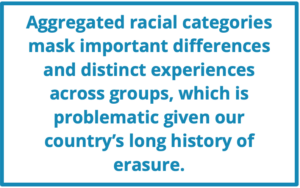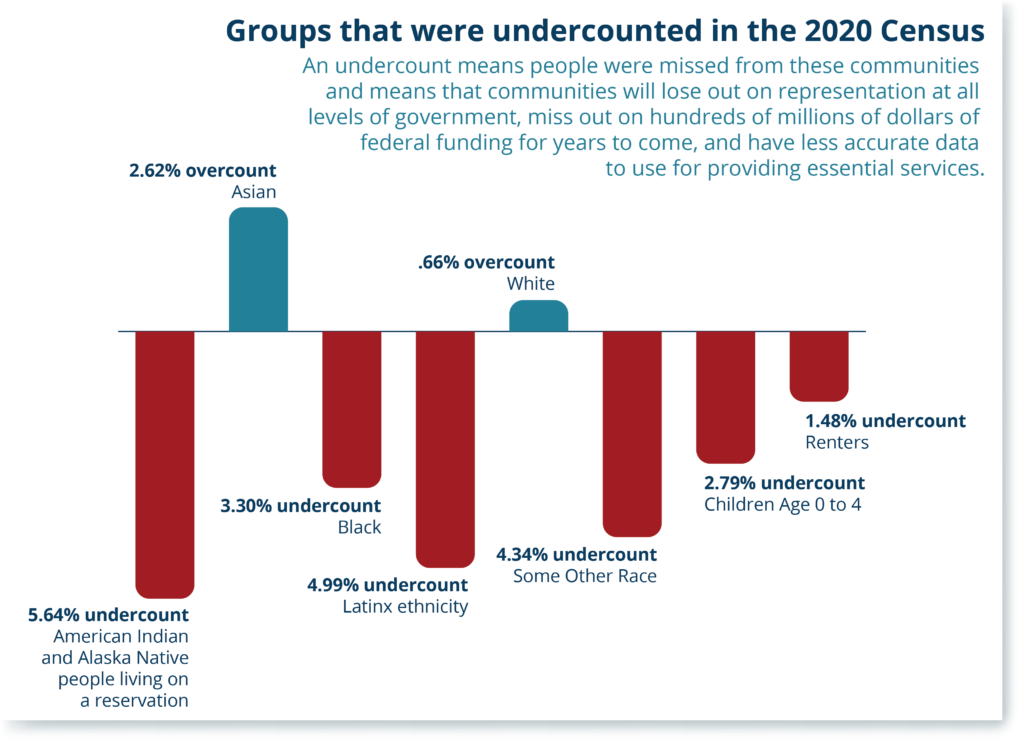The Over-Under on the Census Count
May 2022
Census Must Implement New Data Collection Practices to Stop Undercounting Young Children and Black, Indigenous, and People of Color
The Census released data on under and overcounted populations in the 2020 Census, called the “Post-Enumeration Survey.” Accurate Census counts are important because they help ensure resources are equitably distributed for many programs including schools, child care centers, Medicaid and highway funding, determine voting boundaries and seats in the U.S. House of Representatives, and are used for planning. The stakes are high. North Dakota receives billions of dollars in federal funding each year.

Problematically, the 2020 Census undercounted people who have continually been undercounted: Black or African American, American Indian and Alaska Natives living on reservations, Latinx, and the population categorized by “some other race” on the Census form. Undercounting Black, Indigenous and people of color perpetuates a system that rewards whiteness. Communities that are undercounted in the Census end up with fewer resources from federal allocations, and fewer representatives at the state and federal level.
American Indians and Alaska Natives living on reservations were the most undercounted group at 5.64 percent. The Hispanic or Latinx population follows with an undercount of 4.99 percent, “some other race” was undercounted by 4.34 percent, and the Black population was undercounted by 3.3 percent. Young children are persistently undercounted in the decennial census (age 0-4 were undercounted by 2.79 percent), which has implications for programs like Head Start, child care, and other early childhood programs. Importantly, these undercounts are moving in the wrong direction, having increased for some of these groups since the 2010 Census.

These undercounts come paired with overcounts. White people were overcounted by 0.66 percent and Asian people were overcounted by 2.62 percent. When looking at the entire population, the undercounts and overcounts balance out, and the Census overall is fairly accurate at counting the population as a whole. The overall Census is estimated to have undercounted about 782,000 people across the nation, or 0.24 percent. North Dakota had an undercount of 0.35 percent. However, the accuracy of the overall Census masks inaccuracies within certain groups and communities.
Outdated, historical data collection practices are partly to blame for continually undercounting Black, Indigenous, and people of color. For example, before 2000, many people could not accurately respond to the Census, as they were not allowed more than one race. Someone with American Indian and European heritage would only be counted as American Indian or white in the U.S. Census. This practice resulted in unreliable race data for all sorts of research and forced individuals to exclude part of their identity.
The National Congress of American Indians (NCAI) has been in communication with the Census Bureau expressing concern about a potential undercount of American Indian/Alaska Natives living on reservations in 2020 because of a variety of factors including COVID-19 pandemic shutdowns and a lack of broadband or internet access on reservations.
Accurate Census counts improve how we present data and use it to serve the people of our state and country equitably. Ensuring that data collection and research processes reliably count all population groups can help move policy in the right direction by providing correct information to use in policymaking.

